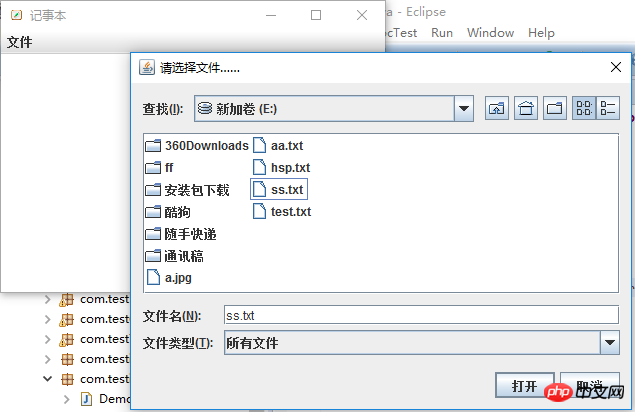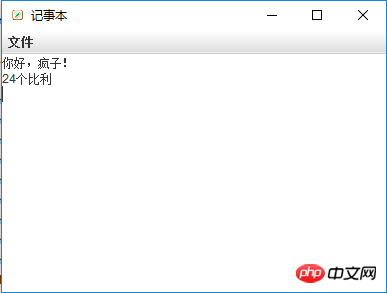 Java
Java
 javaTutorial
javaTutorial
 Detailed explanation of examples of Notepad development using Java file programming
Detailed explanation of examples of Notepad development using Java file programming
Detailed explanation of examples of Notepad development using Java file programming
This article mainly introduces the notepad development of Java file (io) programming in detail. It has a certain reference value. Interested friends can refer to it.
The examples in this article are shared with you. The specific code for Java development of simple notepad is for your reference. The specific content is as follows
public class NotePad extends JFrame implements ActionListener{
//定义需要的组件
JTextArea jta=null; //多行文本框
JMenuBar jmb=null; //菜单条
JMenu jm1=null; //菜单
JMenuItem jmi1=null,jmi2=null; //菜单项
public static void main(String[] args) {
NotePad np=new NotePad();
}
public NotePad(){ //构造函数
jta=new JTextArea(); //创建jta
jmb=new JMenuBar();
jm1=new JMenu("文件");
jm1.setMnemonic('F'); //设置助记符
jmi1=new JMenuItem("打开",new ImageIcon("imag_3.jpg"));
jmi1.addActionListener(this); //注册监听
jmi1.setActionCommand("open");
jmi2=new JMenuItem("保存");
jmi2.addActionListener(this);
jmi2.setActionCommand("save");
this.setJMenuBar(jmb); //加入
jmb.add(jm1); //把菜单放入菜单条
jm1.add(jmi1); //把item放入到Menu中
jm1.add(jmi2);
this.add(jta); //放入到JFrame
this.setDefaultCloseOperation(JFrame.EXIT_ON_CLOSE);
this.setSize(400,300);
this.setTitle("记事本");
this.setIconImage((new ImageIcon("imag_2.jpg")).getImage());
this.setVisible(true);
}
@Override
public void actionPerformed(ActionEvent arg0) {
//判断是哪个菜单被选中
if(arg0.getActionCommand().equals("open")){
//JFileChooser,创建一个文件选择组件
JFileChooser jfc1=new JFileChooser();
jfc1.setDialogTitle("请选择文件……"); //设置名字
jfc1.showOpenDialog(null); //默认方式
jfc1.setVisible(true); //显示
//得到用户选择的文件全路径
String filename=jfc1.getSelectedFile().getAbsolutePath();
FileReader fr=null;
BufferedReader br=null;
try {
fr=new FileReader(filename);
br=new BufferedReader(fr);
//从文件中读取信息并显示到jta
String s="";
String allCon="";
while((s=br.readLine())!=null){ //循环读取文件,s不为空即还未读完毕
allCon+=s+"\r\n";
}
jta.setText(allCon); //放置到jta
} catch (Exception e) {
e.printStackTrace();
}finally{
try {
fr.close();
br.close();
} catch (Exception e) {
e.printStackTrace();
}
}
}else if(arg0.getActionCommand().equals("save")){
//出现保存对话框
JFileChooser jfc2=new JFileChooser();
jfc2.setDialogTitle("另存为……");
jfc2.showSaveDialog(null); //按默认的方式显示
jfc2.setVisible(true);
//得到用户希望把文件保存到何处,文件全路径
String filename2=jfc2.getSelectedFile().getAbsolutePath();
//准备写入到指定文件
FileWriter fw=null;
BufferedWriter bw=null;
try {
fw=new FileWriter(filename2);
bw=new BufferedWriter(fw);
bw.write(this.jta.getText());
} catch (Exception e) {
e.printStackTrace();
}finally{
try {
bw.close();
} catch (IOException e) {
e.printStackTrace();
}
}
}
}
}The running effect is as follows

Click the File button, click the Open menu item, and select a text file. The effect is as follows:

After opening, the content is displayed as follows:

Slightly modify the content and save it as a file named sss. The effect is as follows:

The above is the detailed content of Detailed explanation of examples of Notepad development using Java file programming. For more information, please follow other related articles on the PHP Chinese website!

Hot AI Tools

Undresser.AI Undress
AI-powered app for creating realistic nude photos

AI Clothes Remover
Online AI tool for removing clothes from photos.

Undress AI Tool
Undress images for free

Clothoff.io
AI clothes remover

Video Face Swap
Swap faces in any video effortlessly with our completely free AI face swap tool!

Hot Article

Hot Tools

Notepad++7.3.1
Easy-to-use and free code editor

SublimeText3 Chinese version
Chinese version, very easy to use

Zend Studio 13.0.1
Powerful PHP integrated development environment

Dreamweaver CS6
Visual web development tools

SublimeText3 Mac version
God-level code editing software (SublimeText3)

Hot Topics
 Perfect Number in Java
Aug 30, 2024 pm 04:28 PM
Perfect Number in Java
Aug 30, 2024 pm 04:28 PM
Guide to Perfect Number in Java. Here we discuss the Definition, How to check Perfect number in Java?, examples with code implementation.
 Weka in Java
Aug 30, 2024 pm 04:28 PM
Weka in Java
Aug 30, 2024 pm 04:28 PM
Guide to Weka in Java. Here we discuss the Introduction, how to use weka java, the type of platform, and advantages with examples.
 Smith Number in Java
Aug 30, 2024 pm 04:28 PM
Smith Number in Java
Aug 30, 2024 pm 04:28 PM
Guide to Smith Number in Java. Here we discuss the Definition, How to check smith number in Java? example with code implementation.
 Java Spring Interview Questions
Aug 30, 2024 pm 04:29 PM
Java Spring Interview Questions
Aug 30, 2024 pm 04:29 PM
In this article, we have kept the most asked Java Spring Interview Questions with their detailed answers. So that you can crack the interview.
 Break or return from Java 8 stream forEach?
Feb 07, 2025 pm 12:09 PM
Break or return from Java 8 stream forEach?
Feb 07, 2025 pm 12:09 PM
Java 8 introduces the Stream API, providing a powerful and expressive way to process data collections. However, a common question when using Stream is: How to break or return from a forEach operation? Traditional loops allow for early interruption or return, but Stream's forEach method does not directly support this method. This article will explain the reasons and explore alternative methods for implementing premature termination in Stream processing systems. Further reading: Java Stream API improvements Understand Stream forEach The forEach method is a terminal operation that performs one operation on each element in the Stream. Its design intention is
 TimeStamp to Date in Java
Aug 30, 2024 pm 04:28 PM
TimeStamp to Date in Java
Aug 30, 2024 pm 04:28 PM
Guide to TimeStamp to Date in Java. Here we also discuss the introduction and how to convert timestamp to date in java along with examples.
 Java Program to Find the Volume of Capsule
Feb 07, 2025 am 11:37 AM
Java Program to Find the Volume of Capsule
Feb 07, 2025 am 11:37 AM
Capsules are three-dimensional geometric figures, composed of a cylinder and a hemisphere at both ends. The volume of the capsule can be calculated by adding the volume of the cylinder and the volume of the hemisphere at both ends. This tutorial will discuss how to calculate the volume of a given capsule in Java using different methods. Capsule volume formula The formula for capsule volume is as follows: Capsule volume = Cylindrical volume Volume Two hemisphere volume in, r: The radius of the hemisphere. h: The height of the cylinder (excluding the hemisphere). Example 1 enter Radius = 5 units Height = 10 units Output Volume = 1570.8 cubic units explain Calculate volume using formula: Volume = π × r2 × h (4
 PHP vs. Python: Understanding the Differences
Apr 11, 2025 am 12:15 AM
PHP vs. Python: Understanding the Differences
Apr 11, 2025 am 12:15 AM
PHP and Python each have their own advantages, and the choice should be based on project requirements. 1.PHP is suitable for web development, with simple syntax and high execution efficiency. 2. Python is suitable for data science and machine learning, with concise syntax and rich libraries.





